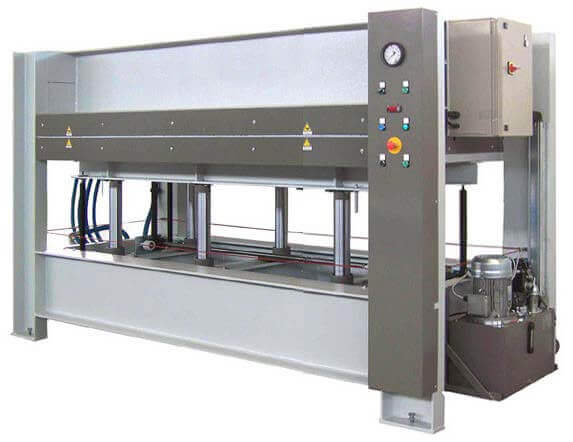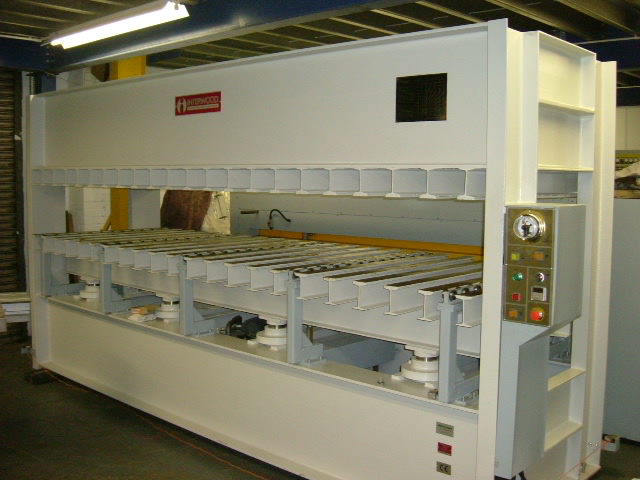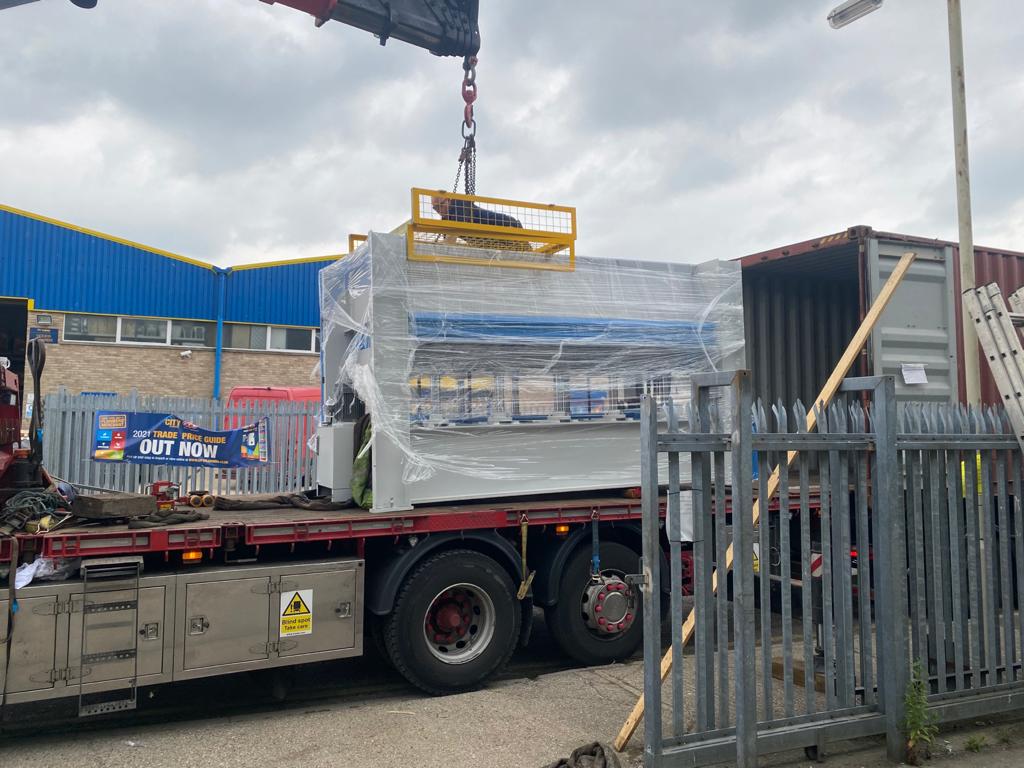Modern hydraulic wood pressing machines will make your production line more efficient, flexible and will reduce overall production costs. Even better, your finished product will have a higher quality finish that will keep your customers very happy.
A machine press is a tool used to deform/shape a work-piece under high pressure. There are different types of machine presses, including cabinet presses, frame presses, solid surface presses, composite presses, multi-daylight presses, cold presses, rubber presses, recycling presses and much more.
The defining characteristic of all machine presses is that they press a work-piece using high pressure to change its shape. The hydraulic press helps to create more pressure.
Hydraulic presses come in many different forms and are used in many different industries.
The basic structure to all presses is a heavy-duty main frame with hydraulic cylinders. The number of cylinders are dependent on the pressure requirement, and they are operated by a hydraulic power pack.
The presses can be manufactured with heated or cold platens and can have conveyors fitted to make the presses automated.
Presses have advanced over the past decade, enabling manufacturers to improve their efficiency and flexibility.
Typical woodworking presses provide different solutions, such as heated, cold, vacuum, or frame.
If you are not sure which type of press would be best for your workshop, here is a bit of information on each type and what they do:
Through-feed presses
Through-feed presses are those where the introduction of panels between the plates and their extraction are fully automated in order to reduce the working cycle and manpower costs.
Through feed presses include:
- Loading table
- Press
- Unloading table
The most common application involves gluing a coating (veneer, laminate, composite, PVC etc) onto a substratum (MDF, hardboard, plywood, hollow panels, blockwood etc).
The basic configuration of the pressing line is comprised of a feed belt, an automatic press and a discharge deck. This configuration can be completed with numerous options, such as glue spreaders, polishers, automatic feeders, disk, roller or belt conveyors, automatic assembling stations, panel turners and stackers.
Lines with various degrees of automation can be supplied right up to fully automatic lines that do not require direct intervention by the operator.
Presses come in various sizes and with various powers/pressures. The presses can be easily adapted to fit a businesses personal requirements.
View a selection of through feed presses
Automated press lines
Automated press lines are designed in conjunction with all through-feed press options to be fully automatic or semi-automatic. They can start at the brushing stage where the material is cleaned, through to gluing, pressing then cutting.
View a selection of automated press lines
Down and up-stroke presses
Modern presses fall into two categories:
- down-acting
- up-acting
A down-acting machine has an upper beam that moves downwards to bring the tooling together.
An up-acting machine has a lower beam that moves upwards to do the same.
Each machine has its own strengths and limitations.
Down-acting press
A typical hydraulic down-acting press uses a pair of hydraulic cylinders, one on each end, to generate the tonnage required for the down stroke of the machine. Traditionally, these machines have a C or O frame profile design. With both types, when facing the front of the machine the hydraulic cylinders are located on the left and right hand side of the upper beam.
Since the upper beam is being pushed down and up with hydraulic power, the upper beam will fall during a power outage and could create an unsafe environment. Down acting presses are commonly blocked at night to take pressure off of the hydraulic system. The lower beam does not move during bending so the operator will not get feedback that the brake is engaged.
Up-acting press
Up-acting machines typically apply hydraulic pressure from the centre of the lower beam which pushes the lower beam upwards into a fixed upper beam.
Tonnage is applied to the centre of the lower beam in an upward fashion. The flex in the bend tends to be even from left to right. Hydraulics are used to push the lower beam up and gravity is used to return the lower beam down. A loss in power will result in the brake being in the open position. Since the lower beam does move during operation, feedback to the operator is given. Knowing the lower beam is moving can be a safety feature.
Stage bending
Down-acting machines are preferred if staged bending is important. Staged bending is a valuable option that can significantly improve productivity while minimising setup time.
Up-acting machines can limit staged bending because of the possibility of ram tilt, staged bending may not be a viable option on an up-acting machine. Because staged bending utilises multiple stations on one machine, if any of the stations on an up-acting machine are too far from the centre, ram tilt may result.
Platen presses
Presses that operate plane to plane are called platen presses.
Virtually any component that goes into a wood or composite panel construction can be manufactured in a process utilising a cold or hot platen style press.
Hot and cold presses
Hop presses use heating platens or rollers, heated with steam, oil or electricity.
Cold presses use ambient platens, or rollers to generate force. The amount of temperature, pressure, time and moisture content all factor into how the process works.
View a selection of hot and cold presses
Cold Press
Hot Press
Multi-daylight presses
A multi-daylight press enables the pressing of multiple panels in one go. Used for veneering chip board, MDF and laminate panels, as well as doors.
Veneer presses
A veneer press uses pressure to hold a veneer against a work-piece to shape and attach while the glue sets. Often used in a system including but not limited to:
- brushing machines
- glue spreading machines
- guillotine
Veneers can be glued to chipboard, MDF, laminate panels, bathroom panels, doors, worktops and much more.
View a selection of veneer presses
Composite presses
Composite presses deal with composite materials that need to be shaped into a usable product.
The automotive trade use them to shape carbon fibre panels and battery boxes for electric cars.
The aero space industry use them for shaping light weight panels and seat covers.
The military use them to create bullet proof floor pans for military vehicles.
The refrigeration industry use them to create cold storage insulation panels for fridges.
View a selection of composite presses
Laminating press
The job of a laminate press is to bond layered materials together to create a stronger material than the original, and also for cosmetic purposes. Many laminating processes involve coating a film, plastic, metal, wood, or other substrate with a surface to strengthen it to be used for a much broader range of purposes.
Laminating is primarily a process used to create building materials for construction so they can handle a larger workload and/or not be easily damaged. They are also used to make furniture decorative - see veneer presses.
Rubber presses
A rubber press deals with materials made from rubber that need to be shaped into a usable product, such as aircraft tyres, as well as rubber or PVC conveyor belts for use in supermarkets and agricultural, industrial and recycling industries, as well airports.
Punch presses
A punch press looks like an ordinary machine press, but it's used to create holes in work-pieces rather than to change the shape. Typically controlled via a CNC machine, a punch press holds a die that's forced against a work-piece using the same high pressure as created by the traditional machine presses. The presence of the die allows the punch press to create holes in the work-piece.
What Allwood provides
Thanks to years of experience in designing and developing presses for the wood industry, Allwood now offers a wide range of models with specific features designed to meet different production requirements for the wood, plastics and metal-working industries.
Virtually any component that goes into a wood or composite panel construction, can be manufactured in a process utilising a cold or hot platen style press.
View Interwood Presses - exclusive new models to Allwood
You can view all of our current presses on our website, but if you can't find what you are looking for please do not hesitate contacting Allwood.


